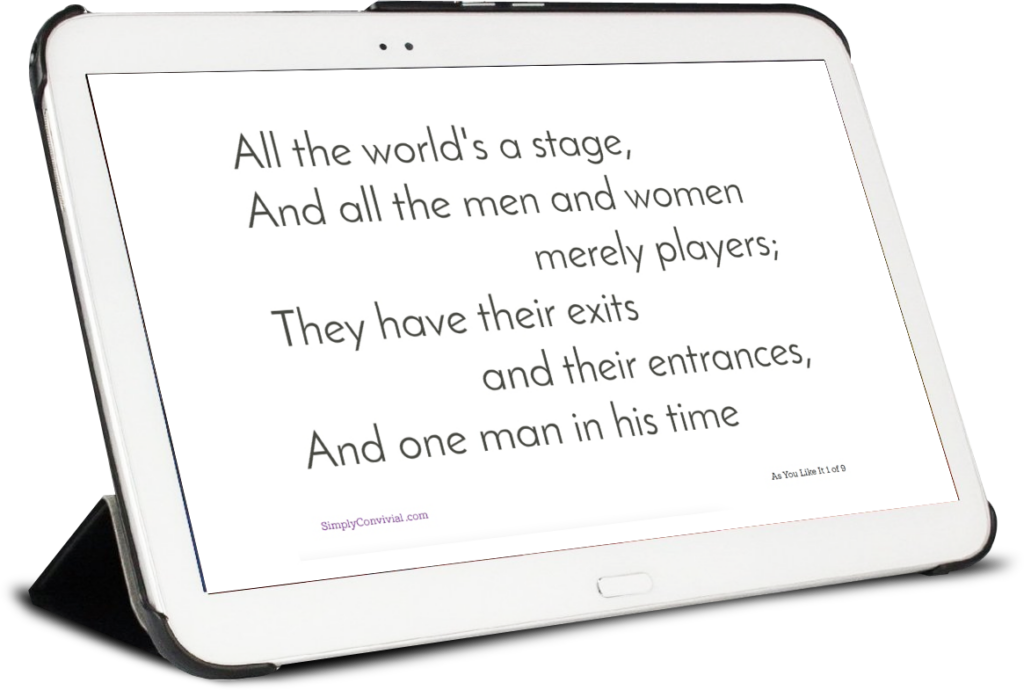Last month I wrote about a 5-step plan for introducing Shakespeare to my kids. It’s what we did last year with three plays and what we’re doing again this year.
Just today I heard my 9-year-old wandering around the house muttering, “murder most foul” and “O, my prophetic soul” to himself – Shakespeare has great mouth-feel.
In my original Shakespeare for Kids post, I wrote:
Shakespeare was written in order to be seen, scripted in order to be performed. Shakespeare wrote popular entertainment, not philosophical treatise. We can draw out deep themes and discuss grand philosophy using monologues and plots we find in Shakespeare, but we should never study Shakespeare to the exclusion of simply enjoying the fun of Shakespeare – Shakespeare was meant to be fun.
So this is my plan to introduce Shakespeare simply as great stories. In the elementary grades we don’t delve into themes and tropes and grand discussions, we just enjoy Shakespeare for the stories and the spectacles.
So far, this approach is working.
This week I’ll lay out what exactly we used for the plays we have done so far, and after we do other plays as the years go on, I will add them to the collection.
Shakespeare for Kids: Taming of the Shrew
I think Taming of the Shrew makes a great first play to introduce Shakespeare to Kids. It’s not a weird or convoluted story; there’s plenty of slap-stick humor and superficial interpersonal conflict that kids completely understand; and the grownups behave outrageously, which seems to amuse children.
Step 1: Introduce Taming of the Shrew
If you want to start of with a brief biography of Shakespeare and his historical setting, Bard of Avon by Diane Stanley is a great one.
It was rather difficult finding a good picture book version of Taming of the Shrew, but this comic book style rendition fit the bill: Taming of the Shrew (Shakespeare for Everyone)
Step 2: Memorize Taming of the Shrew Famous Lines
These are my picks, but you can also browse Shakespeare-Monologues.org for speeches and Absolute Shakespeare for famous one-liners.
For Taming of the Shrew, I picked Kate’s speech:
The more my wrong, the more his spite appears.
What, did he marry me to famish me?
Beggars that come unto my father’s door
Upon entreaty have a present alms;
If not, elsewhere they meet with charity;
But I, who never knew how to entreat,
Nor never needed that I should entreat,
Am starv’d for meat, giddy for lack of sleep;
With oaths kept waking, and with brawling fed;
And that which spites me more than all these wants-
He does it under name of perfect love;
As who should say, if I should sleep or eat,
‘Twere deadly sickness or else present death.
I prithee go and get me some repast;
I care not what, so it be wholesome food.
and Petruchio’s
I’ll attend her here,
And woo her with some spirit when she comes.
Say that she rail; why, then I’ll tell her plain
She sings as sweetly as a nightingale.
Say that she frown; I’ll say she looks as clear
As morning roses newly wash’d with dew.
Say she be mute, and will not speak a word;
Then I’ll commend her volubility,
And say she uttereth piercing eloquence.
If she do bid me pack, I’ll give her thanks,
As though she bid me stay by her a week;
If she deny to wed, I’ll crave the day
When I shall ask the banns, and when be married.
For 5-6 weeks with one play, two selections is plenty. We don’t practice any phrases or one-liners systematically, but generally a few will stand out in the natural course of events and I’ll try to bring them up again in an inside-joke sort of way – because the point isn’t really to memorize Shakespeare, but to love him.
For my part, I love the line “I come to wive it wealthily in Padua; If wealthily, then happily in Padua.” So I often used that quote when transitioning to our Shakespeare portion when we were doing Taming of the Shrew.
Sign up and get instant access to all the Shakespeare memory sheets and lesson plans I’ve created to date.

Step 3: Watch a Taming of the Shrew Movie or Production
I am a firm believer that Shakespeare is meant to be seen, so I think watching a production – live or movie – is an important part of learning and loving Shakespeare. Usually we’ve tried to fit a movie in after reading the picture book summary and introducing the play and before we start the real text.
Live performances of Taming of the Shrew are rare these days since the theme is so politically incorrect. But that’s ok because hands-down the Richard Burton & Elizabeth Taylor version is great fun. Even the 4-year-olds laughed a lot and remained glued to the screen, because it is so over-the-top costumed with plenty of slapstick comedy.
Step 4: Listen to Taming of the Shrew
How a text is read greatly influences comprehension and appreciation, so I like to stick with well-done audio versions of the play along with either coloring or reading along. A Shakespearean actor reading the text simply makes it more understandable, and a British accent makes it more enjoyable, too.
For Taming of the Shrew we used the Dover Shakespeare Coloring Book, Dover’s cheap paperback copy while listening, and Arkangel’s audio version. With older kids who can follow along, I recommend having them follow the script while listening with a cheap Dover edition (these also conveniently do not explain the puns).
Step 5: Play Taming of the Shrew
Taming of the Shrew would be a great play to have the children act out themselves, in their own words. They can get into over-the-top bickering feuds just fine, and have a fun time getting to act that out themselves. And they can see what’s going on without a lot of adult commentary. While watching the movie, one nine-year-old commented, “He’s just treating her the way she was treating others. Now she sees how bad it is.”
No lectures or charts or Socratic discussions necessary – not for elementary students. Just wait and watch and see what connections they draw themselves and I bet you’ll be surprised.
Another way the kids enjoyed acting out Taming of the Shrew was with the Masterpuppet Theatre set. They each picked a scene to read while using the puppets to act it out.
Remember that the point in the pre-high-school years is just to introduce the stories and get Shakespeare into their affections. If they grow up thinking that Shakespeare is fun and normal, they will be ready to dive deep when maturity comes because there will be no fear or intimidation that comes with the assumption that Shakespeare is hard and enigmatic.
When doing Shakespeare with kids, loosen up and remember that the point is caring, being interested, and growing in familiarity.
Shakespeare Lesson Plans
As we study Shakespeare plays together in our homeschool, I am making available our lesson plans and resource lists. Here are the links to each of the plays we’ve studied so far. Included in each one is a downloadable pdf set with not only the lesson plans, but also the printable quote cue pages we use for memorizing select lines from each play!
- How to teach Shakespeare to kids in 5 easy steps
- Comedy of Errors Lesson Plans
- Henry V Lesson Plans
- Hamlet Lesson Plans
- Julius Caesar Lesson Plans
- Taming of the Shrew Lesson Plans
- The Tempest Lesson Plans
- Macbeth Lesson Plans
- Merchant of Venice Lesson Plans
- A Midsummer Night’s Dream Lesson Plans
- Much Ado About Nothing Lesson Plans
- Mystie chats about enjoying Shakespeare in your homeschool on Your Morning Basket with Pam Barnhill














Brilliant. Brilliant brilliant. I can’t wait to start Shakespeare with my kids. My oldest is 7 youngest 3 months. I was going to wait 2 – 3 years to really start with the bard but I am reconsidering. maybe I’ll start next year when number two starts school.